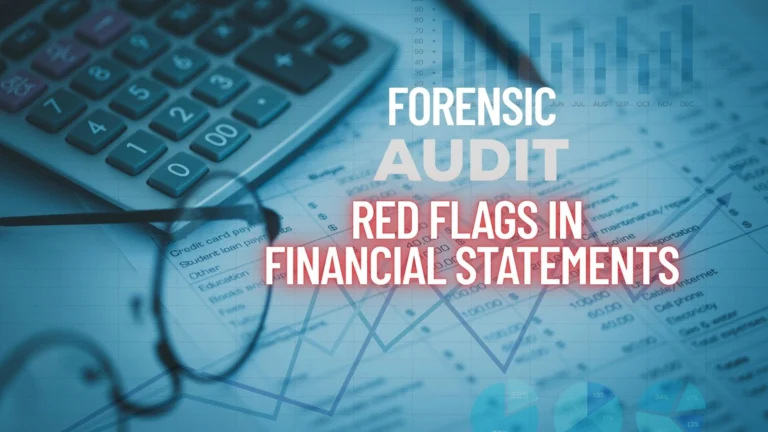Red Flags in Financial Statements 2025: Balance Sheet & P&L

Introduction to Red Flags in Financial Statements
Forensic audits are becoming an increasingly important tool in detecting financial fraud, especially as the complexity of financial statements continues to rise. Whether you’re a CA student, an auditor, or a finance professional, spotting forensic audit red flags in financial statements is crucial for identifying potential fraud and ensuring transparency. In this guide, we’ll delve into the key red flags in financial statements, specifically focusing on the balance sheet and P&L statement, with actionable tips that will help you uncover financial manipulation techniques.
What Is a Forensic Audit?
A forensic audit is a specialized examination of financial statements to identify fraud, misconduct, or other financial discrepancies. Unlike a regular audit that primarily verifies the accuracy of financial statements, a forensic audit digs deeper to uncover any fraudulent activities and is often used as evidence in legal cases.
Why Forensic Audits Are Crucial in 2025
In the current financial landscape, businesses and individuals alike are increasingly under scrutiny for financial mismanagement. High-profile cases like Satyam, IL&FS, and DHFL in India have shown how financial fraud can affect not just companies but the broader economy. Forensic audits are essential in detecting these issues early, allowing auditors and finance professionals to take proactive measures before the situation escalates.
Forensic Audit Red Flags in the Balance Sheet
A balance sheet provides a snapshot of a company’s financial position, but it can also be a tool for manipulation. Here are the key forensic audit red flags you should look for in the balance sheet:
1. Unrealistic Asset Valuations
Inflated valuations of land, buildings, or investments without updated valuations or independent appraisals.
Shifting non-performing assets to a more favorable category (e.g., moving bad debts into “investments” or “long-term assets”).
2. Related Party Transactions
Transactions with subsidiaries, directors, or affiliated companies that don’t appear to have an arm’s-length basis.
Large loans or advances to group companies with little or no interest rate and questionable repayment terms.
3. Fake Receivables or Inventories
Accounts receivable balances that have remained unpaid for extended periods with no proper follow-up.
Inventories that are overvalued, showing quantities that don’t match physical stock levels or slow-moving items classified as “prime.”
4. Excessive Loans or Advances
Loans to entities that have no clear business purpose.
Large advances to related parties or non-operating companies, with little justification or documentation.
5. Off-Balance Sheet Liabilities
Missing disclosures of important liabilities such as guarantees, contingent liabilities, or legal disputes.
Arrangements that hide debt, such as special purpose entities (SPEs), which are not included in the balance sheet.
Forensic Audit Red Flags in the Profit & Loss Statement
The P&L statement can reveal numerous forensic audit red flags, as fraudsters often manipulate revenues or expenses to boost their financial performance artificially. Here are some common indicators:
1. Sudden Spikes in Revenue
A significant increase in sales without any corresponding increase in customers or business activities.
Year-end sales that seem out of line with the rest of the year’s performance, often a sign of channel stuffing.
2. Negative Cash Flow Despite Profits
A business showing profits on paper but struggling with cash flow, indicating potential manipulation of revenue recognition.
Indicates that revenues may have been booked without actual receipts of cash.
3. Unexplained Increase in Margins
Sudden unexplained improvements in profit margins that don’t align with industry trends or operational changes.
Could suggest that costs have been hidden, or revenue has been overestimated.
4. Round Number Entries
Commonly seen in financial statements with revenue or expense entries made in round numbers (e.g., ₹1,000,000 exactly).
Often a sign of fabrication or manipulation of financial data.
5. Frequent Changes in Accounting Policies
Frequent changes in the company’s accounting policies or revenue recognition methods could be a deliberate attempt to manage earnings.
Such changes could obscure underlying financial issues or allow for easier manipulation.
How to Detect Forensic Audit Red Flags
Checklists & Audit Procedures
Use forensic audit checklists to guide your review of financial statements.
Ensure that each key balance is verified with supporting documents.
Ratio Analysis
Analyze financial ratios for anomalies. Look for unusual trends or figures that deviate from industry norms, such as receivables turnover ratio, profitability ratios & operating cash flow.
Interview & Confirmation Techniques
Conduct interviews with management and third parties to get an understanding of the company’s financial practices.
Confirm balances with banks, suppliers, and customers.
Forensic Tools & Excel Hacks
Use advanced Excel techniques like pivot tables, Benford’s Law, and conditional formatting to identify suspicious patterns in large datasets.
Conclusion
Detecting forensic audit red flags requires both a sharp eye for detail and a strong understanding of financial reporting standards. As a CA student or finance professional, you must be vigilant in identifying fraud indicators in the balance sheet and P&L statement.
Key Takeaways:
Understand the common red flags in financial statements and what they signify.
Use audit techniques, including ratio analysis and direct confirmation, to detect potential fraud.
Always maintain a professional and ethical approach to fraud detection.